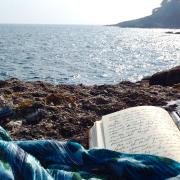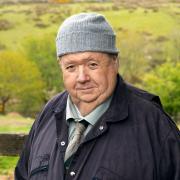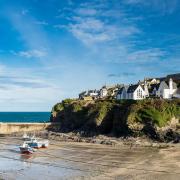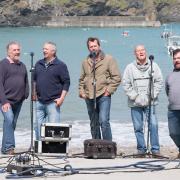Chef and restaurateur Ben Tunnicliffe continues his adventures in Cornwall’s food and drink industry with a nice cup of tea (or five) at Tregothnan

I was intrigued, and that was before it started snowing. The production of tea in Cornwall has always been a bit of an enigma to me – surely this is something we discovered in China, and import from those far-flung climes? Tea is at once so exotic, but also so inherently British, that the bringing together of these two worlds on the banks of the River Fal had to be worth investigating.
And then, as I said, on the day of my visit a light dusting of white covered everything, providing a picturesque backdrop for the fields of daffodils and emerging magnolia flowers in the estate gardens. But it bought the question into even sharper focus, how do they grow tea in this unreliable climate, and if it’s so easy why isn’t everyone doing it?
That first question was answered pretty quickly and in no uncertain terms – it isn’t easy, hence Tregothnan have relative exclusivity as a sizeable British brand. The microclimate the estate enjoys makes it possible, but it is still a case of trial and error; pockets of plantations have been chosen carefully but not always successfully – and sometimes the reasons for failure are hard to fathom.
Our tour began in the stunning gardens, backyard of the Boscawen family who have lived at Tregothnan since 1334. The Himalayan Garden is one small pocket within the grounds of the house (the larger tea plantations are on surrounding estate land) which has done remarkably well. This miniature valley, which slopes down to a small lake overlooked by a Chinese pagoda, is a highlight of the tour; it’s like being transported to the places we usually think of as growing tea!
Despite the snow, we could see fresh growth on the plants which will soon be plucked (the ‘maintenance leaves’ are always left to sustain the bush). Unlike other crops, there is no one harvest time for tea – tender new shoots are repeatedly plucked from March through to October, sometimes longer.
The gardens, which cover 100 acres and descend to the River Fal, are home to many rare and endangered plants which first arrived in the UK via Falmouth Docks. They were bought here to recuperate and for potential propagation, and many never left. Two National Collections of Camellia can be found here, and it is this which gave rise to the idea of tea production on the estate.

Tea is made from Camellia sinensis therefore, the then-head gardener (now MD) Jonathon Jones reasoned, the success of the Camellia collection meant they should also be able to grow tea. The deep-sea creek (the Fal is around 18 metres deep here), which warms the surrounding land from underground, and the acidic soil, were both points in favour of Jonathon’s hypothesis. So, in 1999 the first ever British tea gardens were established and in 2005 (it takes 5-6 years for a bush to start producing a usable crop) the first Tregothnan tea was sold. The majority is blended with parcels of tea carefully sourced from places like Assam and Darjeeling, but they do make a single estate tea.
Back at the Estate Office, we were shown to a specially created tasting room to sample some of the blends made here. Alongside Jonathon, Julie Symons is in charge of crafting the unique character of Tregothnan teas. She has worked on blends with Raymond Blanc (for Eurostar) and James Strawbridge for Nic Roldan’s Sunset Polo, as well as creating a special house blend for Liberty.
Julie guided us through several of the teas, explaining how they were created and how best to enjoy them. Basically, if you have a fine tea you need to treat it with the same kind of reverence as you would a fine wine. Prepare it properly, ie use the right water, using a water purifier if necessary, use leaves rather than bags, drink from fine China and slurp it – the aeration will release the flavour. Originally milk was only added to bad quality tea to counteract the bitterness.
When designing a blend, Julie thinks of an image which suggests the kind of mood she is trying to capture. She then chooses a base; white tea is made from the fine buds and is not oxidised for as long as black tea, green tea is made by steaming the leaves so they retain their colour. In some cases the tea leaves are smoked. Julie then adds other ingredients found on the estate, for example jasmine, fennel seeds, lemon verbena, manuka and mint. My two favourites were a Rose Tea (homegrown black tea, Assam and Rose petals) and the yet-to-be-released Saffron Fields made with strands of saffron sourced from Saffron Walden. Both had complex layers of scent and intriguing textures, which reminded me of the sensory experience of tasting really good wines.
Not just for tea buffs (I’m a hardened coffee drinker myself), the Tea Masterclass is a rare opportunity to enjoy the private estate, as the gardens are only open to the public for a charity event once a year. It’s a fascinating eye-opener into the world of tea production which is guaranteed to change the way you choose and prepare your daily brews.
The Tea School Masterclass is £145 per person including a Cornish Cream Tea. Book via tregothnan.co.uk.
About Ben Tunnicliffe
Ben has been a champion of Cornwall’s food and drink scene since he settled here in 2001. His Newlyn pub, The Tolcarne Inn, serves the freshest seafood around, while his eponymous beach-side eatery in Sennen delivers family-friendly dining in a stunning location.
Follow Ben on Twitter @ben_tunnicliffe



























